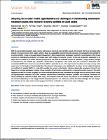| dc.contributor.author | Ali, Muhammad | |
| dc.date.accessioned | 2022-09-15T10:11:41Z | |
| dc.date.available | 2022-09-15T10:11:41Z | |
| dc.date.issued | 2022 | |
| dc.date.submitted | 2022 | en |
| dc.identifier.citation | Muhammad Ali; Pei-Ying Hong; Himanshu Mishra; Johannes Vrouwenvelder; Pascal Saikaly, Adopting the circular model: opportunities and challenges of transforming wastewater treatment plants into resource recovery facilities in Saudi Arabia, Journal of Water Reuse and Desalination, 2022 | en |
| dc.identifier.other | Y | |
| dc.identifier.uri | http://hdl.handle.net/2262/101157 | |
| dc.description.abstract | With the ever-growing population, water, energy, and resources need to be used carefully, reused, and renewed. There is an increasing global interest in resource recovery from ‘waste’, which is driven by sustainability and environmental concerns and motivated by the potential for economic benefits. A new era in waste (water) management is being realized where wastewater treatment is becoming part of the circular economy by integrating the production of reusable water with energy and resource recovery. In this new perspective, wastewater is no longer seen as a waste to be treated with energy expenditure but rather as a valuable resource of freshwater, energy, nutrients (nitrogen and phosphorous), and materials (e.g., bioplastics, cellulose fibres, and alginate). In this review paper, the conversion of wastewater treatment plants (WWTPs) into resource recovery factories (RRFs) is presented as one of the ways forward to achieve a circular economy in the water sector for the Kingdom of Saudi Arabia (KSA). The advanced technologies, some highlighted in the article, can be installed, integrated, or retrofitted into existing WWTPs to create RRFs enabling the recovery of freshwater, cellulose, alginate-like exopolymers (bio-ALE), and biogas from municipal wastewater achieving climate neutrality, decarbonization, and production of new and promising resources. The article highlights the need for modular, adaptive, and/or decentralized approaches using sustainable technologies such as aerobic granular sludge (AGS)-gravity-driven membrane (AGS-GDM), anaerobic electrochemical membrane bioreactor (AnEMBR), and anaerobic membrane bioreactor (AnMBR) for conducive localized water reuse. The increase in reuse will reduce the pressure on non-renewable water resources and decrease dependency on the energy-intensive desalination process. This article also outlines the water challenges that are arising in KSA and what are the major water research programmes/themes undertaken to address these major challenges. | en |
| dc.language.iso | en | en |
| dc.relation.ispartofseries | Journal of Water Reuse and Desalination; | |
| dc.rights | Y | en |
| dc.subject | Circular economy | en |
| dc.subject | Resource recovery | en |
| dc.subject | Waste to resource | en |
| dc.subject | Water reuse | en |
| dc.title | Adopting the circular model: opportunities and challenges of transforming wastewater treatment plants into resource recovery facilities in Saudi Arabia | en |
| dc.type | Journal Article | en |
| dc.type.supercollection | scholarly_publications | en |
| dc.type.supercollection | refereed_publications | en |
| dc.identifier.peoplefinderurl | http://people.tcd.ie/alim3 | |
| dc.identifier.rssinternalid | 245643 | |
| dc.identifier.doi | https://doi.org/10.2166/wrd.2022.038 | |
| dc.rights.ecaccessrights | openAccess | |
| dc.relation.doi | https://iwaponline.com/jwrd/article/doi/10.2166/wrd.2022.038/90531/Adopting-the-circular-model-opportunities-and | en |
| dc.relation.source | IWA | en |
| dc.relation.cites | Cites | en |
| dc.subject.TCDTheme | Smart & Sustainable Planet | en |
| dc.subject.TCDTag | Bioreactors | en |
| dc.subject.TCDTag | Microengineering, micromachining | en |
| dc.relation.sourceuri | https://iwaponline.com/jwrd/article/doi/10.2166/wrd.2022.038/90531/Adopting-the-circular-model-opportunities-and | en |
| dc.identifier.orcid_id | 0000-0003-3360-1622 | |
| dc.status.accessible | N | en |




